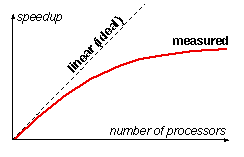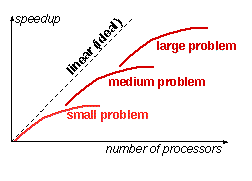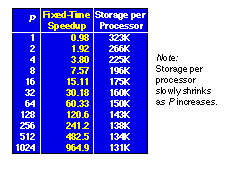In measuring performance of parallel computers, the usual method is to choose a problem and test execution time as the processor count is varied. This model underlies definitions of "speedup," "efficiency," and arguments against parallel processing such as Ware's formulation of Amdahl's law. Fixed time models use problem size as the figure of merit. Analysis and experiments based on fixed time instead of fixed size have yielded surprising consequences: The fixed time method does not reward slower processors with higher speedup; it predicts a new limit to speedup, more optimistic than Amdahl's; it shows efficiency independent of processor speed and ensemble size; it sometimes gives non-spurious superlinear speedup; it provides a practical means (SLALOM) of comparing computers of widely varying speeds without distortion.
The main reason we use computers is speed. True, they often produce work of higher quality and reliability than other means of doing a task, but these are really just forms of speed. With enough time, pencil-and-paper calculations can match the quality and reliability of a computer. It is the speed of computers that lets us do things we otherwise would not try.
The reason we use parallel computers instead of serial computers is also for speed. This seems so obvious that we seldom belabor the point. Yet, we base everything we do in parallel computing on this motive. The problem is that our usual definition of "speed" is not on very firm ground. Most papers skirt the issue of absolute speed and instead report "speedup," defining speedup strictly as time reduction.
The following cynical definition by Ambrose Bierce, from The Devil's Dictionary (1911), shows the absurdity of basing parallel performance on time reduction:
Bierce used this reasoning as humor almost a century ago. Now we call the flaw in the reasoning "Amdahl's law" and treat it as a serious obstacle to parallel performance. By scaling the problem to sixty post-holes, the absurdity disappears and the sixty men are sixty times as productive as a single man. My thesis is that parallel performance should be measured by the work done in fixed time, and not by time reduction for a fixed problem.
It seems clear that speed, for a computer, is work divided by time. But, what is "work"? The following common "myths" of speed and performance measurement illustrate difficulties involved in defining work:
A Fortran example shows the fallacy of this idea:
Figure 1. FLOP-Count Counterexample
The only floating point operations are in the DO 1 loop, which has order N complexity. By current convention for measuring MFLOPS, the work in this problem is 103. However, the DO 2 loop has integer operations and is of order N2 complexity. Even the oldest digital computers would be misjudged by ignoring the relative cost of 106 integer operations, despite their much higher times for floating point operations. But, the DO 3 loop is the most troublesome since it has order N3 complexity and has no "operations" by common measures. Yet, memory operations are the most commonly-used instructions on computers.
The earliest computers were like humans in the respect that they took much longer to do arithmetic, especially multiplies, than to read operands or write results. The situation we now see, compute-intensive processors much faster at arithmetic than data motion, is not intuitive. In the early days of computing, gates (vacuum tubes) dominated both the system cost and the execution time; the wires connecting them were cheap by comparison. Current high-end computer costs and times are dominated by the connections, and the gates are cheap by comparison. Even recent numerical analysis texts base their complexity analysis on the economics of outdated arithmetic-bound machines.
In an example from Parkinson [22], elegantly expressed in Fortran 90, a serial processor might do more work than a parallel ensemble:
Figure 2. "Best Serial Algorithm" Counterexample
A serial processor can only do the operations with some type of loop that references each element in turn, as stored in linearly addressed memory. A data-parallel computer like a MasPar or Connection Machine does nothing so complicated. Each of 1024 processors only needs to compute three address references and one addition, with no loop management. One could argue that the elements had to be dispersed to the 1024 processors in the first place. But, this isn't true in the context of a larger application that contains the operation. Which defines the minimum work? The serial computer that must add, store the result, increment three memory pointers, test a loop counter, and branch? Or, a parallel computer that simply adds and stores the result? The example in Section 2.1 shows we cannot neglect simple overhead-type operations, no matter how trivial they may seem. A "proof" of the nonexistence of superlinear speedup by Faber, Lubeck, and White [10] relies implicitly on the assumption there is no savings from diminished loop overhead.
A similar counterexample occurs in tree-search problems. When a depth-first search is divided to run on a parallel computer, the resulting search is partly breadth-first. The breadth-first search sometimes does less work to find a particular goal. To reproduce the parallel search pattern on the serial computer involves extra serial work to change the entire "stem" in skipping from one part of the tree to another.
Counterexamples to this are rampant. To use a recent example that compares four very different computers, consider the following result from the "EP" Monte Carlo simulation taken from the NAS Parallel Benchmarks [4]:
Table 1a. Failure of Peak MFLOPS as Performance Predictor
Where is the pattern? All except the nCUBE use pipelined vector arithmetic. All except the CRAY are highly parallel. (This benchmark does almost no communication, so interprocessor speed ratings can be neglected.)
The nCUBE 2 exceeds "peak" speed because 64-bit floating point multiply-add operations determine the rated MFLOPS, but the benchmark involves roots, multiplies modulo 246, and logarithms counted as 12, 19, and 25 operations. The NAS weights are apparently based on CRAY Y-MP measurements. Since the nCUBE 2 does those things in less than 12, 19, and 25 times the time for a floating-point multiply or add, it exceeds its "peak speed."
A partial resolution for this case appears if you use "peak memory bandwidth," the rate at which all the processors can use main memory (not cache) under ideal conditions:
Table 1b. Example of Memory Bandwidth as Performance Predictor
The bottom line is consistent enough to suggest that peak bandwidth instead of peak MFLOPS is a better simplistic predictor for this application. If peak MFLOPS correlated even weakly with observed rankings of computers, it would still be a practical tool for predicting performance. Alas, the failure of peak ratings even to rank computers correctly happens often in practice.
The previous section illustrated some of the current difficulties in assessing computer performance. The following section discusses historical attempts to analyze performance, especially parallel speed improvement. The definitions at the end of this section represent an attempt to provide a new theoretical basis for performance analysis that avoids some of the classical dilemmas.
Twenty years ago, Ware [31] first summarized Amdahl's [2] arguments against multiprocessing as a speedup formula, popularly known as Amdahl's law. Amdahl's law shows a limit to performance enhancement. It was the only well-known parallel performance criterion until its underlying assumptions were questioned by Benner, Montry, and myself in our work at Sandia National Laboratory [14]. Based on experimental results with a 1024-processor system, we revised the assumptions of Amdahl and proposed the scaled speedup principle [13, [14]. Our argument was, and is, that parallel processing allows us to tackle previously out-of-reach problems. So, as problem size is increased with computing power, the serial component as defined by Amdahl and Ware cannot be regarded as constant.
Since then, researchers have sought a better understanding of parallel speedup. In 1989, Van-Catledge [30] and Zhou [34] studied the relation between Amdahl's law and scaled speedup. Eager et al. [9] studied speedup versus efficiency. Barton and Withers [5] developed a speedup model which considers the manufacturing cost of processors as a performance factor. In 1990, Karp and Flatt [18] suggested using the Amdahl-type serial fraction in an ad hoc sense. Worley showed the time constraints of scaled speedup [9]. Sun and Ni studied the relation between different speedup models [27], and Sun proposed a new metric to show aspects of the performance not easily seen from other metrics [29].
The definitions of "speedup" and "efficiency" are ingrained in the parallel processing literature. Speedup is the time on one processor divided by the time on P processors. Authors almost universally define speedup as sequential execution time over parallel execution time. The chosen sequential algorithm is the best sequential algorithm available, not the parallel algorithm run on one processor. (Sometimes the terms absolute speedup and relative speedup distinguish these approaches [29], with the latter meaning comparison with the parallel algorithm run on one processor.)
Efficiency is usually "speedup divided by P." For vector computers, efficiency often means operations per second divided by peak theoretical operations per second. Generally, speedup and efficiency depend on both N and P. Suppose C(N) represents the complexity of the best serial algorithm for a size N problem, and CP(N) is the complexity of the parallel algorithm run on P processors. Then
1. Introduction
Major Premise: Sixty men can do a piece of work sixty times at quickly as one man.
This may be called the syllogism arithmetical, in which, by combining logic and mathematics, we obtain a double certainty and are twice blessed.
Minor Premise: One man can dig a post-hole in sixty seconds.
Conclusion: Sixty men can dig a post-hole in one second.
2. Myths of Performance Measurement
2.1 Myth: The "work" is the operation count.

2.2 Myth: The best serial algorithm defines the least work necessary.

2.3. Myth: Peak MFLOPS ratings correlate well with application MFLOPS.


3. Background and Definitions
3.1 A "Speedup" History



 C ( No)
C ( No) C (Np) / C (No )
C (Np) / C (No ) (12)
(12)



 (14)
(14)

 .
.

